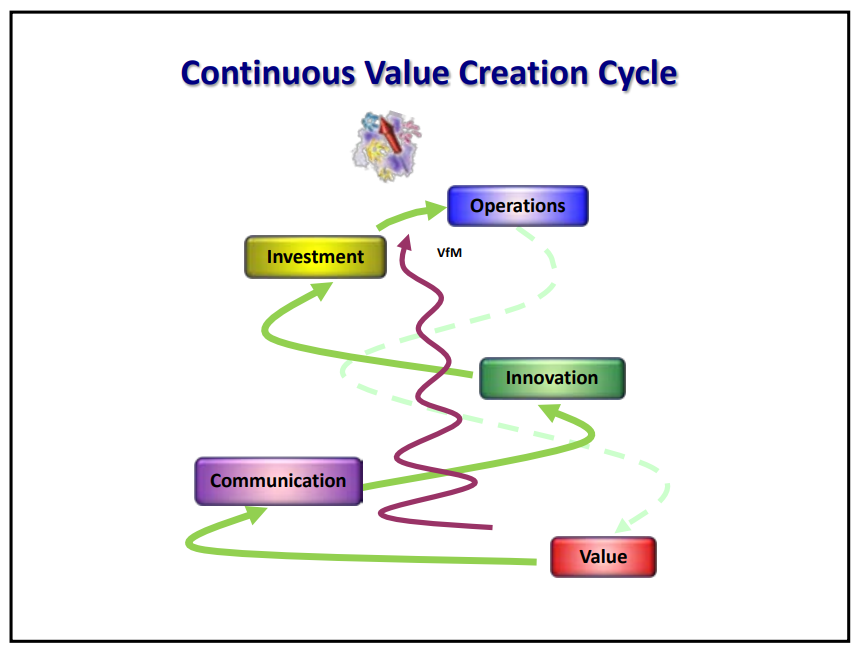Is Collaboration Value a Mirage?
Introduction
Time and again we have seen Boards announce a collaborative alliance in order to pull off a ‘magical marriage’. They will bid for contracts that were previously out of reach; put products on the shelves at a fraction of the cost of their competitors’; dream up a new product which will corner the market; and provide a super service package well beyond anything they have ever done before. Two years later when none of these objectives have been achieved, they have no idea why things have gone wrong.
From our perspective there is a gulf between these grandiose views of collaborative value and the ability of management to translate these into achievable goals. Even in the largest companies there seems to be a failure to understand that collaboration means pooling resources and working together to achieve objectives that neither could do on their own. This means a whole new idea of what value is, how it is created and how it is captured.
What is Value?
Probably most will see value as the achievement of increased profits, greater market share and the fulfilment of project objectives. These will be underpinned by operational imperatives of time, cost, quality and delivery. However, there is more to value than this. A number of intangible factors will also come into play such as innovation, knowledge and skills capture, enhanced reputation and brand value and, satisfied stakeholders. More difficult to quantify but equally important as an enabler, is relationship quality. This is characterised by harmony, trust, commitment, open communications and a willingness to work together for the long-term. Altogether these value components will have short and long-term aspects and, because of the nature of collaboration, there will be aspirational, potential and emergent opportunities that will have an impact.
When companies start working collaboratively they often begin with specific aims. These will take into account the known capabilities on both sides. As they move forward further abilities will become evident. More open and in-depth communication will occur, creativity and innovation will be stimulated and, the partners will broaden their focus to include these and ‘up their game’. Suddenly ideas that were vague dreams become achievable. This provides impetus for joint investment that enables the partners to seize unforeseen opportunities as they arise. It is this enhanced capability of the partnership which forms the potential aspect of collaborative value. It becomes a method of working that is capable of continuous value creation as the quality of the relationship increases. Therefore the partners must expect that unforeseen value opportunities will emerge and be prepared to manage their creation and exploitation. Thus contrary to some traditional views that collaborative relationships can be established immediately simply by having the right partner selection process and signing the contract, it is clear that collaborative working, value creation and capture develop in an increasingly productive cycle as shown below.
Broken Cycles
Seventy five percent of alliances fail to live up to expectations because they don’t enter the Continuous Value Creation cycle. The reasons are many but overall the lack of clear focus on what the value proposition is and how it is to be achieved leads to unreality in the way that the relationships develop. The partners will inevitably have different views and if these are not reconciled into a joint one from the start, then the divergence of objectives will sow the seeds of relationship failure.
We have been struggling for over two years to make this partnership work. Staff at all levels are frustrated by our inability to work together more productively. It has recently dawned upon us that this might be because we didn’t re-negotiate the contract when we decided to become collaborative.
Global IT Outsourcer
There are a number of common situations where the Continuous Value Creation cycle is interrupted and value is lost:
- Not Adapting to Change – New requirements aren’t recognised and reconciled, a gulf opens up between the partners.
“We couldn’t change the relationship to access the supplier’s wider expertise therefore we terminated it and looked for a new one where we could.” IT Outsourcer
“We want to deliver a Total Facilities Management Service but the customer just wants cleaners and security guards.” Global FM Service Provider
- Level blockers – The Board may well be d’accord on the benefits of collaboration but their failure to communicate this clearly to the various levels in their organisation leads to staff feeling threatened by the requirement for a more cooperative approach and resisting the development of the relationship.
“I know what they want but it’s too airy-fairy for a construction company. You try and be nice and the customer jumps all over you.” Chief Engineer, Global Construction Company
- Value confusion – Relationship disharmony is confused with poor relationship performance which reduces the perception of the value generated. This could result in a highly productive relationship failing.
“We hate working with them but we can’t find anybody else who does it better.” Global Food Manufacturer
- Feel good/complacency – This is the ‘party culture’ where the relationship has settled into a cosy groove where ‘inconveniences’ such as financial governance and process improvements are ignored. Poor performance is masked by good intentions and high activity. Value capture is subordinated to an easy ride and things start to go ‘south’ when the bills come in.
“We built them a terrific electricity sub-station but unfortunately it flooded the first time it rained. They still paid us for it though, and the re-work.” Power Sub-Contractor, National Construction Project
- Bad targets – You continue to lay year-on-year price reductions on your supplier; does this incentivise him to work collaboratively? Or, a partner maximises his efficiency at the expense of the other, is this good team work?
“They just dump these precision instruments on the dockside with no protective packaging because they are keen to go on leave after their voyage. We are only contracted to service the things but then get hammered by their commercial people for charging the extra to fix them because they are broken.” UK Defence Contractor
- The Seized Cycle – Innovation in the relationship has stopped, the partners have become dependent on each other rather than interdependent. Due to market factors they are unable to find a replacement for each other and have to ‘stay together for the sake of the kids’.
“We are more concerned with metrics than achievement. We spend more time ‘Weighing the Pig’ than feeding it!” IT Vendor/Vendor Partner
- Out of touch – Value capture has slowed because one of the partners has failed to stay aware of the other’s increasing skills, knowledge and capability.
“The reason why we have been struggling to launch a new product is because we are wedded to old technology. We have just found out that our partner can supply far more capable modern components!” Electronics Designer/Manufacturer
- Unrealised Dreams – The partners are unable to convert the dream into reality. Because they fail to understand the full potential of the relationship they devote insufficient effort to make it work and they are unable to capitalise on its potential and opportunities.
“We felt they weren’t trying so we went off to talk to a competitor. Unfortunately they found out.” IT Vendor/Vendor Partner
Post-mortem - The Struggle to Realise Value
Based upon a number of major cases that we have been involved with over the last 15 years the following sequence portrays how lack of appreciation of collaborative value results in a struggling relationship.
The Boards decide that there is considerable value in adopting a collaborative relationship. In particular tapping into the wider capabilities of the partners will enable more innovative ways of working leading to lower costs and greater efficiency.
At this point they assume their senior management will define what is meant by working collaboratively and will identify the commercial and operational changes that are needed to secure the desired value. Unfortunately this expectation is often not fulfilled.
Senior management meet with the commercial managers and the sales people. Not realising that they need to explore a completely new way of working with their opposite numbers, they hammer out a revised contract. This looks very much like the old one but incorporates the increased requirements that they think the new, closer relationship should deliver and with additional governance clauses needed to manage it. Usually because their focus is on the bottom line there is minimal or reduced investment with for example a demand for a year-on-year 5% price reduction.
The new contract then hits the operational levels like a bolt from the blue. It contains expectations that they are either unable to satisfy or require considerable changes to implement and often, with cost penalties. Furthermore, there is no plan for the re-alignment of the organisations to make possible a new way of joint working. As a result, staff increase their work rate in fruitless pursuit of the new targets. Frustration and friction levels inevitably rise and adversely affect performance. Eventually penalty clauses are threatened and the commercial managers get involved.
Increased innovation is a significant expectation of this contract, although it does not specify how it is to be incentivised or rewarded. Furthermore, new communications channels to discuss innovative value creation and capture are not established. At the operations levels frenzied activity and performance issues leave very little scope or appetite for developing and implementing new ideas.
After a period of time it is evident that the collaboration is not delivering the value envisaged and the Boards begin to question the original concept. The fact that the collaboration initiative was not implemented is not recognised as the source of failure. This top level doubt starts to permeate into the alliance organisations…………..
Focusing on Value Creation and Realisation
Collaboration is where firms freely enter into relationships in order to work together using their specialised resources innovatively to achieve aims and objectives they could not achieve individually. When they come together within an effective relationship it is possible to open up new opportunities to share increased rewards.
The Enterprise Relationship Management (ERM) framework developed by us, is a structure for co-ordinating all the business activities that are essential to the success of a joint/multi-party endeavour. It puts in place a management system that has the ability to always create and capture the maximum joint value possible within the relationship. It does this by bringing partnership management into sharp focus so that it is proactive and accountable. It is comprised of formal organisational arrangements that ensure all activities are jointly managed at all levels. It must be supported by an objective performance measurement system that focuses the partners on a clear, joint understanding enabling them to get things done to time, cost and quality. Its success is dependent upon the commitment of dedicated resources. Eventually it will become a valuable capability in its own right as expertise grows in the management of complex business relationships.
The combination of framework contracts and relational governance within the ERM structure generates higher collaborative relationship performance based upon a joint, agreed view of value. The framework contract defines the required governance arrangement and the broad objectives of the relationship. It becomes a living entity that adapts to the changing needs of the joint business. It promotes stability and thus supports the relationship’s capacity to respond to the challenges. Relational governance provides the essential behaviours and attitudes such as openness, honesty, trust, co-operation and long-term orientation and, greater resilience in the face of operational and commercial risks. Savvy organisations who ‘do it right’ from the start will develop a robust relationship which is capable of producing super returns today and a long-term revenue stream.
The new framework contract runs for 5 years at a fixed cost. This gives us guaranteed service availability and a 20% reduction in costs. The Supplier is incentivised to be innovative and increase equipment reliability. In return he can plan his work load more effectively, cut overheads and home in on fault trends.
UK Ministry of Defence Helicopter Project Manager
Conclusion
Organisations that decide to collaborate often take a limited view of value. They don’t understand what it really means for both parties, how they capture it and how they will continue to take advantage of new prospects. They thus fail to put in place a collaborative management structure and environment that establishes and enters them into the Continuous Value Creation Cycle. The relationship becomes ‘fractious’, innovation does not happen and productivity is only average at best. The investment under performs and customers are disappointed. Currently this happens far too often and viable alliance opportunities are wasted. In our view collaborative value remains a mirage for all but a small minority.
Further Reading
Implementing and Managing Collaborative Relationships, A Simple Guide, Andrew Humphries and Linda McComie, 2012
ISBN 978 0 7552 1436 5
For further information contact
Telephone: +44 1 908 561892
Email: sales@sccindex.com
Website: www.sccindex.com
©Copyright Andrew Humphries and Linda McComie, March 2014
60 Colts Holm Road, Old Wolverton, Milton Keynes, MK12 5QD, UK
Registered in England No. 5150526 VAT No. 844 9460 96
Would you like to contribute an article towards our Professional Knowledge Bank? Find out more.



